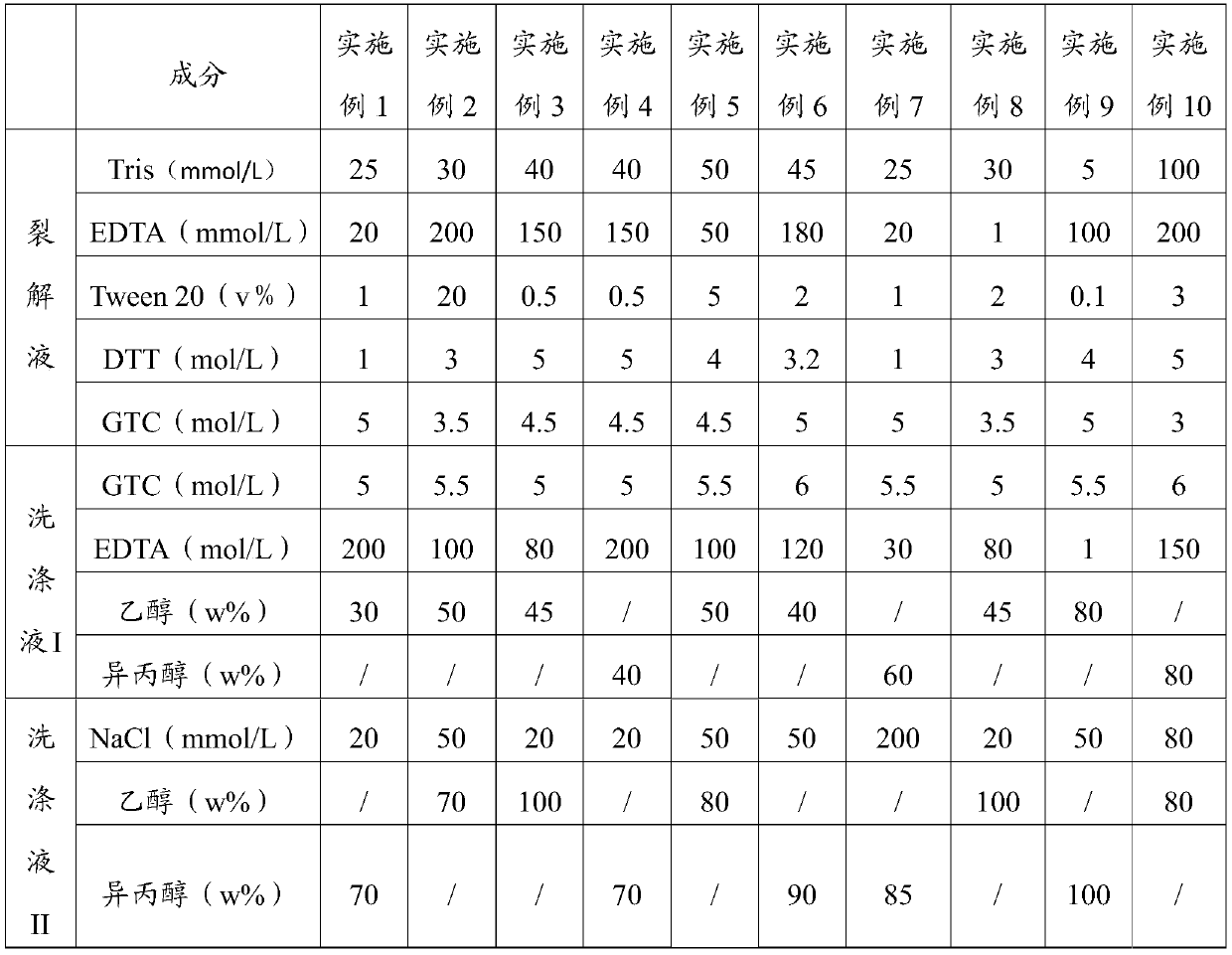Nucleic acid extraction kit and nucleic acid extraction method
A nucleic acid extraction reagent and nucleic acid extraction technology, applied in the field of molecular biology, can solve problems such as the influence of relational quantity recovery, low microbial extraction efficiency, difficulty in microbial extraction, etc., to ensure accuracy and stability, and to avoid mixed blood and secretions. interference, protection stability and complete effect
- Summary
- Abstract
- Description
- Claims
- Application Information
AI Technical Summary
Problems solved by technology
Method used
Image
Examples
Embodiment 11
[0039] A method for extracting nucleic acid specifically includes the following steps:
[0040] Step 1. Mix the lysate and the sample to be extracted at 10°C for 5 minutes, then add the nucleic acid attachment and mix at 40°C for 5 minutes to obtain the nucleic acid attachment that has adsorbed nucleic acid;
[0041] The sample to be extracted is an alveolar lavage fluid from non-affected patients; the nucleic acid attachment is magnetic beads;
[0042] Step 2. Use washing liquid I to soak the nucleic acid attachments with nucleic acid at 40°C, and use magnetic separation to perform solid-liquid separation to obtain supernatant I and the nucleic acid attachments after one wash;
[0043] Use washing solution II to soak the nucleic acid attachments after one wash at 10°C for 1 min, and use magnetic separation for solid-liquid separation to obtain supernatant II and the nucleic acid attachments after the second cleaning;
[0044] Use the eluate to soak the nucleic acid attachments after th...
Embodiment 12
[0047] A method for extracting nucleic acid specifically includes the following steps:
[0048] Step 1. Mix the lysate and the sample to be extracted at 40°C for 2 minutes, then add the nucleic acid attachment and mix at 10°C for 2 minutes to obtain the nucleic acid attachment that has adsorbed nucleic acid;
[0049] The sample to be extracted is an alveolar lavage fluid from non-affected patients; the nucleic acid attachment is magnetic beads;
[0050] Step 2. Use washing solution I to soak the nucleic acid attachments with nucleic acid adsorbed at 10°C for 5 minutes, and use magnetic separation for solid-liquid separation to obtain supernatant I and the nucleic acid attachments after cleaning once;
[0051] Use washing solution II to soak the nucleic acid attachments after washing once at 40°C for 5 minutes, and use magnetic separation for solid-liquid separation to obtain supernatant II and the nucleic acid attachments after the second washing;
[0052] Use the eluate to soak the nuc...
Embodiment 13
[0055] A method for extracting nucleic acid specifically includes the following steps:
[0056] Step 1. Mix the lysate and the sample to be extracted at 25°C for 3 minutes, then add the nucleic acid attachment and mix for 3 minutes at 25°C to obtain the nucleic acid attachment that has adsorbed nucleic acid;
[0057] The sample to be extracted is an alveolar lavage fluid derived from a non-affected patient (definitely not suffering from a lower respiratory tract disease); the nucleic acid attachment is a magnetic bead;
[0058] Step 2. Use washing liquid I to soak the nucleic acid attachments with nucleic acid adsorbed at 25°C for 3 minutes, and use magnetic separation to perform solid-liquid separation to obtain supernatant I and the nucleic acid attachments after one wash;
[0059] Use washing solution II to soak the nucleic acid attachments after one wash at 10°C for 2 minutes, and use magnetic separation for solid-liquid separation to obtain supernatant II and the nucleic acid atta...
PUM
 Login to View More
Login to View More Abstract
Description
Claims
Application Information
 Login to View More
Login to View More - R&D
- Intellectual Property
- Life Sciences
- Materials
- Tech Scout
- Unparalleled Data Quality
- Higher Quality Content
- 60% Fewer Hallucinations
Browse by: Latest US Patents, China's latest patents, Technical Efficacy Thesaurus, Application Domain, Technology Topic, Popular Technical Reports.
© 2025 PatSnap. All rights reserved.Legal|Privacy policy|Modern Slavery Act Transparency Statement|Sitemap|About US| Contact US: help@patsnap.com

